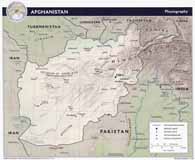Report From Afghanistan: Part 1: One Enemy, Many Faces
“The Big Red One†arrives in eastern Afghanistan
April 2012. The 1st Infantry Division, the fabled “Big Red One,†arrived at Bagram Airfield to take over the fight in Eastern Afghanistan. The division was taking the reins at a critical time, just ahead of a massive drawdown of forces that would see U.S. troop numbers cut by a third over the summer. (Pat Proctor)
Editor’s Note: U.S. Army Lieutenant Colonel Pat Proctor recently deployed to Afghanistan with 1st Infantry Division. Before he departed, Proctor agreed to send ACG a series of “Reports from Afghanistan” to share with our readers his and the division’s experiences during their deployment by giving ACG readers a unique “boots on the ground” perspective. Proctor’s first report provides an overview of the situation today in Afghanistan and sets the stage for his upcoming future reports in this series.
As the U.S. 1st Infantry Division, the storied “Big Red One,” takes charge of Regional Command-East (RC-East) – an area the size of Pennsylvania surrounding the capital province of Kabul, with an ethnically diverse population of 7 to10 million Afghans – it does so at a challenging time. American public support for the war is at an all-time low and the U.S. force is in the midst of a drawdown that will see its numbers cut by nearly a third (to 68,000) by the end of the year. The 1st Infantry Division also takes charge in a very challenging environment, beset by a variety of enemy groups with often contradictory aims.
{default}Al Qaeda
After the May 2, 2011 death of Osama bin Laden, al Qaeda is wounded but not destroyed. While many of the senior leaders are believed to be hiding in Pakistan, mid-level leaders are attempting to reestablish safe havens in the rugged, mountainous terrain of Nuristan province. In their weakened state, they depend on the Taliban for their protection, sustenance, and survival.
 The Taliban
The Taliban
Operating from two separate shuras (ruling councils) in Peshawar and Quetta inside Pakistan and still nominally led by Mullah Omar, the Taliban thwarts the ability of the Afghan government in Kabul to project outside of the major cities in RC-East by subverting government power in the lawless rural areas where over 80-percent of the population lives. With a precisely calibrated blend of terroristic threatening and harsh but effective justice, they offer the false promise of stability to war-weary areas that the government cannot reach.
The Haqqani Network
Loosely affiliated with the Taliban, the Haqqani Network is the most lethal and dangerous threat in RC-East’s area of operations. The group is led by Mawlawi Jalaluddin Haqqani – grizzled veteran of both the 1979-89 Soviet-Afghan war and the post-Soviet Afghan civil war – from a safe haven in Miram Shah, Pakistan. Funded by Pakistan’s Inter-Service Intelligence (ISI) and aided and sheltered by the anti-government Zadran and Andar tribes of Pashtun Paktiya and Ghazni provinces, this network defies both Afghan security forces and the Taliban leadership by conducting high-profile attacks in Kabul directed against civilians.
Hezb e Islami Gulbuddin
Perhaps most indicative of the confusing state of the Afghan insurgency is the Hezb e Islami Gulbuddin. The group is, at once, a legitimate political party participating in the Afghan government, a criminal enterprise, and an insurgency. The party’s leader, Gulbuddin Hekmatyar (another veteran of the Soviet-Afghan war) has entered a political alliance with President Hamid Karzai that has won him governorships of several key provinces south of Kabul. At the same time, his party’s armed wing fights Afghan security forces and coalition forces in Kunar, Laghman, and Kapisa provinces for control of criminal smuggling routes and the Taliban for control of the lucrative Nerkh apple trade in Wardak province south of Kabul.
Click here to see all the articles that have been published in this series of reports from Afghanistan.
Lt. Col. Pat Proctor is currently deployed to eastern Afghanistan, serving as the chief of plans for the 1st Infantry Division. He is a veteran of both the Iraq and Afghan wars and is a doctoral candidate in history at Kansas State University. Proctor is the author of TASK FORCE PATRIOT AND THE END OF COMBAT OPERATIONS IN IRAQ (Government Institutes, 2011) and MEDIA WAR: THE MEDIA-ENABLED INSURGENCY IN IRAQ (Kindle ebook, 2010). His next book will be IDEAS TO DIE FOR: SEIZING THE ARAB SPRING TO MOVE BEYOND THE WAR ON TERRORISM. ACG invites readers to visit Proctor’s website, prosimco.com/writing/.
NOTE: The views expressed in this article are those of the author and do not reflect the official policy or position of the Department of Defense or the US Government.



0 Comments
Trackbacks/Pingbacks